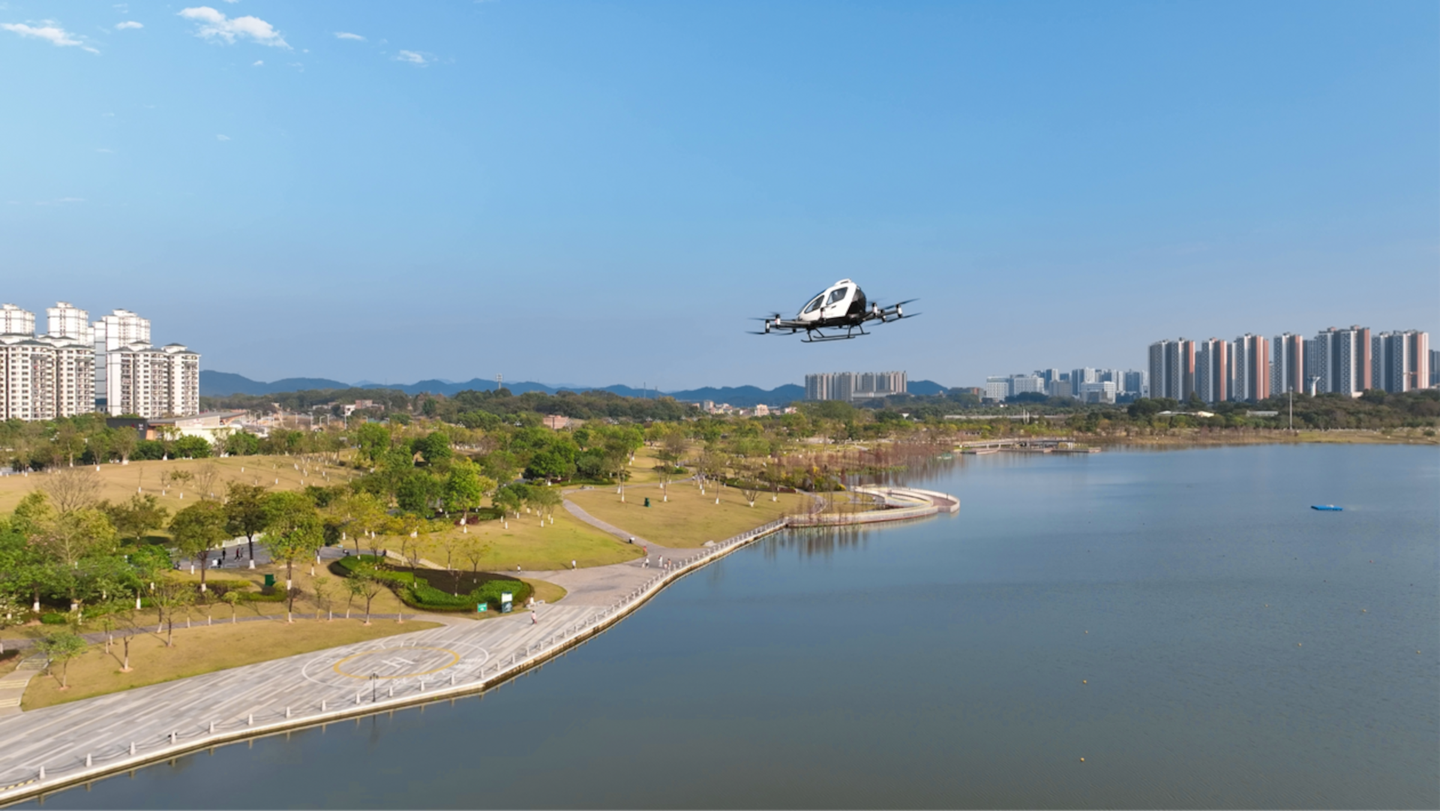EHang Reveals Low $330K Price Tag for Self-Flying Electric Air Taxi
Many passenger-carrying electric vertical takeoff and landing (eVTOL) aircraft are expected to cost millions to produce, but EHang will sell its EH216-S for far less.

EHang’s self-flying, two-passenger EH216-S conducts flight demonstrations at Jiulong Lake Park in Guangzhou, China, on December 28, 2023. [Courtesy: EHang]
Chinese manufacturer EHang has revealed the price tag of its type-certificated, electric vertical takeoff and landing (eVTOL) air taxi—and it’s relatively cheap.
At least, by eVTOL standards. EHang suggested a retail price of 2.39 million Chinese Yuan—or about $330,000—for the self-flying, two-seat aircraft in China, expected to take effect on April 1. The manufacturer is the first in the world to obtain type certification for an eVTOL air taxi, and its EH216-S has already flown commercial demonstrations with ticketed customers.
EHang cited the market potential and industry scale of China’s low-altitude economy—equivalent to the U.S.’s urban air mobility (UAM) industry—and the trend of rapid global growth in low-altitude aerial services as factors in its pricing. The company said its price tag will best serve the needs of the market while raising the value of eVTOL and UAM services in China.
“The low-altitude economy and its related industries present a significant market opportunity for our UAM development and serve as a new engine for future economic growth in China,” said Huazhi Hu, founder, chairman and CEO of EHang. “We remain committed to safety in aircraft research, production, operation, and commercial services, which ensures that each of our pilotless aircraft continues to lead in innovation…Our aim is to make pilotless aerial vehicles a common part of everyday life, bringing its benefits to a broader public.”
EHang’s suggested retail price appears staggeringly cheap when considering expectations for its competitors. Very few have publicly proposed price tags for their own aircraft. But those who have are looking at a different bracket entirely. Lilium, for example, has said its Pioneer Edition Jet will cost in the range of $7 to 10 million.
Archer Aviation CEO Adam Goldstein, meanwhile, projected the company’s Midnight air taxi will initially cost $2 to 2.5 million to produce, eventually falling to $1 million. United Airlines agreed to purchase 100 Midnight aircraft in a deal worth $1 billion, which would equate to $10 million per aircraft.
Joby Aviation—which intends mostly to operate its own aircraft rather than selling to customers—estimates each air taxi will cost $1.3 million to manufacture, according to a 2021 investor presentation. They have not set a public price; however, as under the current business model, they will all be operated by Joby or the military and not sold to the public.
In fact, most models are expected to cost millions to produce. And with many manufacturers focused on paying back the investors who have poured millions or even billions into aircraft development, it’s unlikely they will sell at EHang’s price level for the foreseeable future.
Worth noting is that the EH216-S’s $330,000 price tag is only proposed for China—EHang could adjust it for other markets. The low figure may be a play to get as many air taxis humming in China’s skies as possible before expanding internationally, which Hu told CNBC could happen as soon as this year.
Designed primarily for low-altitude sightseeing and urban tourism, the EH216-S carries two passengers or 485 pounds of payload on 22 sm (19 nm) routes, cruising at 62 mph (54 knots). By and large, these specifications are more restrictive than those of its competitors. Midnight, for example, is built for up to four passengers, with a 100 sm (87 nm) range and 130 knots cruise speed.
The design stands out, though, for its autonomy. Many manufacturers are, understandably, scared off by the prospect of flying without a pilot. Boeing’s Wisk Aero, for example, is one of a handful of firms looking to fly autonomous from the jump, targeting commercial service in 2028. China, however, is introducing self-flying eVTOLs before piloted variants.
The EH216-S, unlike its competitors, is also wingless. It instead deploys a coaxial dual-propeller architecture, with eight foldable arms housing 16 lift-and-thrust rotors. The company says this keeps the design light, reduces space, and minimizes the structural components needed to install propellers and motors.
EHang in October became the first eVTOL air taxi manufacturer to obtain the coveted type certification from the Civil Aviation Authority of China (CAAC). The groundbreaking approval came with certain operational restrictions, such as on routing, scheduling, and flights without visual observers. But the company said it will gradually lift these as service ramps up.
Operations soft-launched in December with the first EH216-S commercial demonstration flights, following CAAC airworthiness approval. EHang customer Eton, which received the first airworthy model that month, flew ticketed customers over Guangzhou’s Jiulong Lake Park, while another air taxi soared over Hefei’s Luogang Central Park.
The flights did not quite mark an official commercial launch. But they were the first of their kind in the world involving real customers and were witnessed by high-ranking government officials and citizens alike.
EHang is getting help from authorities in both Guangzhou and Hefei, both of which have supported it with financing and the creation of low-altitude infrastructure. It has a similar relationship with officials in Shenzhen, where customer Shenzhen Boling Holding Group Co. received the first batch of its order for 100 air taxis in September.
The manufacturer has yet to announce production certification for the EH216-S, which would round out the trifecta of approvals considered necessary for a new aircraft to reach scale. However, it has a fully operational production facility in the city of Yunfu in Guangdong Province, where it is ready to ramp up manufacturing when the time comes.
Like this story? We think you'll also like the Future of FLYING newsletter sent every Thursday afternoon. Sign up now.

Subscribe to Our Newsletter
Get the latest FLYING stories delivered directly to your inbox






